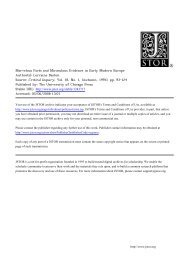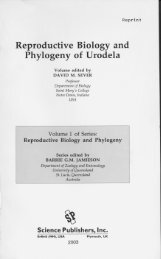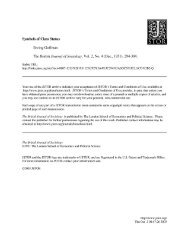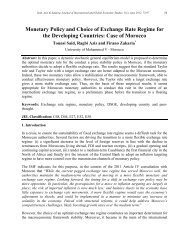Ultrastructure and Histochemistry of the Adhesive Breeding Glands ...
Ultrastructure and Histochemistry of the Adhesive Breeding Glands ...
Ultrastructure and Histochemistry of the Adhesive Breeding Glands ...
You also want an ePaper? Increase the reach of your titles
YUMPU automatically turns print PDFs into web optimized ePapers that Google loves.
878 Copeia 2008, No. 4<br />
Light microscopy.—Tissues from <strong>the</strong> left half <strong>of</strong> <strong>the</strong> venter<br />
were rinsed for 1 hr in tap water <strong>and</strong> dehydrated in a graded<br />
series <strong>of</strong> ethanol (70%, 95%, for 1 hr each, 100%, two cycles<br />
for 30 min each). Tissues were <strong>the</strong>n placed in toluene (two<br />
cycles for 30 min each) <strong>and</strong> subsequently embedded in<br />
paraffin blocks for sectioning with a MR3 (Research <strong>and</strong><br />
Manufacturing Co., Tucson, AZ) microtome. Sections<br />
10 micrometers (mm) thick were cut <strong>and</strong> affixed to albumenized<br />
slides. Alternate slides were stained with hematoxylineosin<br />
(H&E) for general histological examination, alcian<br />
blue 8GX (AB) at pH 2.5 for carboxylated glycosaminoglycans<br />
<strong>and</strong> periodic acid-Schiff’s (PAS) for neutral carbohydrates<br />
or bromophenol blue (BB) for proteins. All histological<br />
techniques followed Kiernan (1990). Slides were viewed<br />
under a Leica DM2000 (Leica Microsystems, Wetzlar,<br />
Germany) microscope, <strong>and</strong> images were obtained via a Leica<br />
DFC420 (Leica Microsystems, Wetzlar, Germany) digital<br />
camera.<br />
Electron microscopy.—Tissues from <strong>the</strong> right half <strong>of</strong> <strong>the</strong><br />
venter were rinsed in deionized water <strong>and</strong> <strong>the</strong>n post-fixed<br />
for 90 min in 2% osmium tetroxide. Tissues were subsequently<br />
rinsed in deionized water, dehydrated with a graded<br />
series <strong>of</strong> ethanol (70%, 95%, 100%, for 1 hr each), soaked<br />
30 min each in 1:1 100% ethanol:propylene oxide followed<br />
by pure propylene oxide, <strong>and</strong> embedded in an epoxy resin<br />
(EmBed 812, Electron Microscopy Sciences, Fort Washington,<br />
PA). Ultra-thin sections, at 70 nm, were achieved by use<br />
<strong>of</strong> DiATOME diamond knives (DiATOME, Biel, Switzerl<strong>and</strong>)<br />
on a RMC MT7 (Research <strong>and</strong> Manufacturing Co., Tucson,<br />
AZ) ultramicrotome. Ultra-thin sections were placed on<br />
copper grids <strong>and</strong> stained with uranyl acetate <strong>and</strong> lead<br />
citrate. Grids were viewed <strong>and</strong> photographed with a JEOL<br />
JEM 100S (JEOL USA, Peabody, MA) transmission electron<br />
microscope.<br />
RESULTS<br />
Histology <strong>and</strong> histochemistry.—Using Conaway <strong>and</strong> Metter<br />
(1967) as a guide, adhesive gl<strong>and</strong>s were located in <strong>the</strong> sternal<br />
region <strong>of</strong> Gastrophryne carolinensis <strong>and</strong> at <strong>the</strong> base <strong>of</strong> <strong>the</strong><br />
inner arm (Fig. 1B). In <strong>the</strong>se regions, adhesive gl<strong>and</strong>s are<br />
more numerous <strong>and</strong> histologically distinct from typical<br />
serous <strong>and</strong> mucous gl<strong>and</strong>s. <strong>Adhesive</strong> gl<strong>and</strong>s are composed <strong>of</strong><br />
a simple cuboidal epi<strong>the</strong>lium surrounding a large luminal<br />
area that is connected to <strong>the</strong> surface <strong>of</strong> <strong>the</strong> epidermis by a<br />
small duct (Fig. 1C). The epi<strong>the</strong>lium <strong>of</strong> <strong>the</strong> breeding gl<strong>and</strong>s<br />
is strongly eosinophilic, intensely PAS+, AB2, <strong>and</strong> BB2<br />
(Table 1). Eosinophilic <strong>and</strong> PAS+ secretory material can be<br />
observed in <strong>the</strong> lumen <strong>of</strong> <strong>the</strong>se gl<strong>and</strong>s <strong>and</strong> on <strong>the</strong> surface <strong>of</strong><br />
<strong>the</strong> epidermis during amplexus (Fig. 1C). Mucous gl<strong>and</strong>s<br />
appear much smaller than adhesive gl<strong>and</strong>s <strong>and</strong> exhibit<br />
pyrimoidal secretory cells surrounding an empty lumen<br />
(Fig. 1C). The epi<strong>the</strong>lium <strong>of</strong> <strong>the</strong> mucous gl<strong>and</strong>s is basophilic,<br />
PAS+, AB+, <strong>and</strong> BB2 (Table 1). The serous gl<strong>and</strong>s lack an<br />
obvious lumen <strong>and</strong> contain <strong>the</strong>ir products in a syncytium<br />
(Fig. 1C). This syncytium is eosinophilic, intensely BB+,<br />
PAS+, <strong>and</strong> AB2.<br />
<strong>Ultrastructure</strong>.—The three distinct gl<strong>and</strong> types were identified<br />
for ultrastructural analysis from comparison with <strong>the</strong><br />
histological results above. The substance produced in <strong>the</strong><br />
adhesive gl<strong>and</strong>s is electron dense <strong>and</strong> contained in tightly<br />
packed secretory granules with small mitochondria inter-<br />
Copeia cope-08-04-19.3d 27/10/08 10:59:02 878 Cust # CG-07-144R<br />
spersed (Fig. 1D). These granules dominate <strong>the</strong> cytoplasm <strong>of</strong><br />
<strong>the</strong> cuboidal epi<strong>the</strong>lial cells during amplexus <strong>and</strong> because <strong>of</strong><br />
<strong>the</strong>ir high concentration, exhibit <strong>the</strong> polyhedral-like shape<br />
common in tightly packed clusters (Brizzi et al., 2003;<br />
Fig. 1D,F). Myoepi<strong>the</strong>lial cells surround <strong>the</strong> periphery <strong>of</strong><br />
<strong>the</strong>se gl<strong>and</strong>s (Fig. 1D). Rough endoplasmic reticulum is<br />
abundant in <strong>the</strong> basal portion <strong>of</strong> <strong>the</strong> epi<strong>the</strong>lial cells<br />
surrounding irregularly shaped, heterochromatic nuclei<br />
(Fig. 1E). Microvilli are abundant on <strong>the</strong> luminal border <strong>of</strong><br />
<strong>the</strong> epi<strong>the</strong>lium (Fig. 1E). Intercellular canaliculi are narrow.<br />
Desmosomes can be observed basally connecting epi<strong>the</strong>lia<br />
(Fig. 1E), but apical junctions appear to be lost during<br />
amplexus.<br />
Our ultrastructural analysis demonstrates an apocrine<br />
mode <strong>of</strong> secretion in adhesive breeding gl<strong>and</strong>s. The<br />
secretory granules dissociate from <strong>the</strong> epi<strong>the</strong>lium intact,<br />
surrounded by cytoplasmic material, including microvilli<br />
(Fig. 1F). Individual granules <strong>the</strong>n combine to form a<br />
uniform secretory material that dominates <strong>the</strong> lumen<br />
during amplexus (Fig. 1F). Secretory material is highly<br />
concentrated on <strong>the</strong> surface <strong>of</strong> <strong>the</strong> epidermis upon which<br />
<strong>the</strong> ducts leading from <strong>the</strong> adhesive gl<strong>and</strong>s open (Fig. 1F<br />
insert).<br />
Serous gl<strong>and</strong>s differ greatly in ultrastructure from adhesive<br />
breeding gl<strong>and</strong>s. These gl<strong>and</strong>s contain secretory granules <strong>of</strong><br />
varying electron densities in a syncytium (e.g., no discernable<br />
membranes are observed between cells that make up<br />
<strong>the</strong> serous gl<strong>and</strong>s; Fig. 2A). Heterochromatic nuclei can be<br />
observed around <strong>the</strong> periphery <strong>of</strong> <strong>the</strong> syncytium with<br />
myoepi<strong>the</strong>lial cells surrounding <strong>the</strong> serous gl<strong>and</strong>s (Fig. 2A).<br />
Serous syncitia possess dense cytoplasms that make it<br />
difficult to observe <strong>the</strong> cytoplasmic contents <strong>of</strong> <strong>the</strong><br />
syncytium (Fig. 2A).<br />
In contrast to serous gl<strong>and</strong>s, mucous gl<strong>and</strong>s are ultrastructurally<br />
similar to adhesive gl<strong>and</strong>s. Electron-dense<br />
secretory granules fill <strong>the</strong> pyramidal epi<strong>the</strong>lium (Fig. 2B).<br />
Heterochromatic nuclei are basally to centrally located,<br />
depending on secretory phase, <strong>and</strong> myoepi<strong>the</strong>lial cells<br />
envelop <strong>the</strong> mucous gl<strong>and</strong>s (Fig. 2B). Intercellular space is<br />
slightly increased, while microvilli decrease in number<br />
compared to that <strong>of</strong> adhesive breeding gl<strong>and</strong>s (Fig. 2C).<br />
Rough endoplasmic reticulum (Fig. 2D) <strong>and</strong> mitochondria<br />
(Fig. 2C) are abundant in <strong>the</strong> epi<strong>the</strong>lium, while desmosomes<br />
(Fig. 2C) can be observed joining <strong>the</strong> epi<strong>the</strong>lial cells<br />
toge<strong>the</strong>r apically. The major differences between <strong>the</strong><br />
mucous gl<strong>and</strong>s <strong>and</strong> <strong>the</strong> adhesive breeding gl<strong>and</strong>s are <strong>the</strong><br />
smaller size <strong>of</strong> <strong>the</strong> mucous gl<strong>and</strong>s compared to that <strong>of</strong> <strong>the</strong><br />
adhesive breeding gl<strong>and</strong>s <strong>and</strong> a merocrine mode <strong>of</strong> secretion<br />
in <strong>the</strong> mucous gl<strong>and</strong>s in contrast to an apocrine mode in <strong>the</strong><br />
adhesive breeding gl<strong>and</strong>s.<br />
DISCUSSION<br />
Metter <strong>and</strong> Conaway (1969) studied <strong>the</strong> development <strong>of</strong><br />
adhesive gl<strong>and</strong>s in Gastrophryne carolinensis following treatment<br />
<strong>of</strong> juvenile males <strong>and</strong> females with testosterone <strong>and</strong><br />
regression <strong>of</strong> adhesive gl<strong>and</strong>s in castrated males. Due to <strong>the</strong><br />
similarities in an undeveloped or regressed condition, <strong>the</strong>y<br />
proposed that adhesive breeding gl<strong>and</strong>s are derived mucous<br />
gl<strong>and</strong>s, a hypo<strong>the</strong>sis supported by <strong>the</strong> histochemical results<br />
<strong>of</strong> Holloway <strong>and</strong> Dapson (1971). The histochemical <strong>and</strong><br />
ultrastructural results presented here fur<strong>the</strong>r support this<br />
hypo<strong>the</strong>sis. These distinctive gl<strong>and</strong>s produce a neutral<br />
carbohydrate material <strong>and</strong> contain all <strong>the</strong> cellular machinery<br />
<strong>of</strong> a derived mucocyte, including polyhedral secretory







